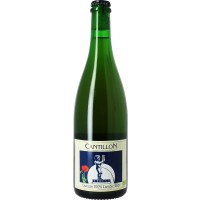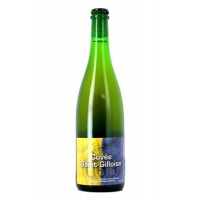Buy Cantillon Kriek 100% Lambic Bio - Cantillon Gueuze 100% Lambic Bio - Cantillon Cuvée Saint-Gilloise (Champions)



Kriek 100% Lambic Bio
The most famous among the fruit beers is without doubt the Kriek.
On a warm summer day, a lorry coming from the auction at Sint-Truiden delivers 4.000 kgs of fresh Kellery cherries to the brewery. The brewery staff will then put about 150 kgs of fruits in oakwood or chestnutwood barrels which can contain 650 litres of lambic and which have been cleaned some days before.
These barrels are filled with healthy lambics which are more or less one and a half year old. These are not so easy to find, because many beers are still ill at that age. These "oily" beers will have to mature for some months in the main barrel. When the Kriek barrels are filled with the fruits and with the lambic (about 500 litres), the hole in the barrel is closed with a sheet of paper in order to avoid contact with impurities.
Five days later, the fermentation starts. The sugars from the lambic and from the fruits bring about the activity of the yeasts which are concentrated in the wood and in the skin of the fruits. A marvelous pink or red foam decorates the old barrels in the cellar.
Normally, the fermentation stops around the 10th of August. The barrels are then closed and the acid lambic begins to extract the taste and the colour from the fruits. Flies and mosquitoes haunt the cellars and are likely to provoke bad infections. Due to the presence of the home spider, however, a natural predator which is more efficient than any insecticide, the Cantillon Brewery presents a natural equilibrium which enables us to produce our beers.
The fermentation of the Kriek in the bottle generally starts in the beginning of October. Two barrels of Kriek from the first extraction and two from the second are pumped into a huge barrel. (The second extraction is obtained by filling the barrel for a second time in order to extract as much from the fruits as possible). It is also possible to blend a certain quantity of young lambic with the Kriek in order to obtain a second fermentation in the bottle. The Kriek goes through a natural saturation, normally after three to five months in the bottle. We recommend to drink the Kriek within one year after the bottling.
The fermentation will change the primary taste of the product and the Kriek will be dominated by the character of the lambic. The red colour will change into more oily shades. This is, however, a personal point of view. Some customers conserve their Kriek for a long time and like it that way. Kriek is a traditional summer beer. It is a very thirst-quenching beer which tastes deliciously with a big slice of brown bread with white cheese, radishes, onions and chives.
Years ago, people who drank Kriek in a pub were also given two lumps of sugar and a "stoemper" on a small plate. With the "stoemper", the customer could crush the sugar on the bottom of his glass and sweeten it in a natural way in order to eliminate the sour taste.
Cantillon Gueuze Lambic Bio
También conocida como Cantillon Gueuze 100% Lambic Bio / Classic / Organic
-------------
Blend of lambics produced during different years.
Beer with a slightly acidic and fruity taste, delicate and woody fragrance and a dry finish that lingers on the palate.
Beer with taste evolution that will keep for a long time in a good cellar.
Color: golden yellow
Cuvée Saint-Gilloise (Champions)
Several years
A new brew concocted by Jean Van Roy to celebrate the 2003-2004 Division III title for the local Union St. Gilles football team and its upgrade to Division II.
Cuvee des Champions is not a traditional ’gueuze,’ in that it is made from only two year-old 2001 lambic, not from a blend of older and younger lambics. It is also dry-hopped in the cask for three weeks with fresh Styrian Goldings hops. Re-fermentation in the bottle is achieved with the addition of a small amount of candi sugar.
2022 - Two-year-old lambic in which fresh HallertauMittelfrüh hops have been soaked. A perfect balance is struck between the lambic’s natural acidity and the Hallertau hops’ refined bitterness.
- BrewDog Punk IPA AF - Laugar Punkarra
- Stillwater / L’Anjub Aloja Catalan Farmhouse Ale - Brooklyn Monster Ale - 18th Street Jade
- Domus Summa - Portus Brezo
- La Pirata Tremenda - La Pirata Black Block Brandy Barrel Aged - La Pirata Lupulus Pirata
- Lindemans Gueuze - Dame Jeanne Brut D’Anvers
- Against The Grain / Mikkeller Bloody Show - Mikkeller Recipe # 1000 BA Sauternes
- Jester King Drink`in the sunbelt - Brooklyn Brown Ale - Ballast Point Fathom IPL
- La Surfera Summer Ale - La Quince Double Baden IPA - XaBier’s L’Andragó
- Stella Artois - Budweiser - Negra Modelo
- Beercat Barcelona Blonde - Cornèlia Rumba - Cornèlia Soul
- Rosita Picant - Rosita Bomba - Rosita White IPA
- Ambar Export - Alhambra Reserva 1925 - Maset Cerveza de Abadía Premium
- Hidromiel Odin - Odin Chicha de Piña - Odin Loki
- Steinburg Negra Dark - Buenasuerte Amuleto Black Lager - Cusqueña Negra Dark Lager
- Guinness Draught - Pauwel Kwak - La Corne du Bois des Pendus Black
- Heineken - Affligem Blonde - Birra Moretti L’Autentica / Ricetta Originale
- Gulden Draak 9000 Quadruple - Augustijn
- Dawat 100 - Doggerlander Belgian Dark Ale
- Mahou Cinco Estrellas - Mahou Clásica
- Marky Ramone’s 40 Years Of Punk - Karl Strauss Tower 10 IPA - 7B Siete Barrios Caperucita y el Lobo
- Fuller’s London Pride - Fran Luis El pont penjant d’Amposta - Rituals
- Implik2 / Santa Pau Ales Ipantoja - Dunham / Kissmeyer Leo’s Early Breakfast IPA - Guineu / Moor Juicy Jones
- Ruben’s Pilsen - La Masovera Truja Fera - Barret Jaapi
- Struise Black Damnation - Zombination V M.A.N.O.L.O. - Struise Brouwers Black Damnation XXVI Froggie
- Pacífico Clara - Corona Extra - Estrella
- Voll-Damm - Alhambra Reserva Roja
- Anchor Old Foghorn Barley Wine Style Ale - Anchor California Lager - Anchor San Franpsycho IPA
- Elysian Beers of Apocalypse - 8 - Maelstrom - Jaira American Tuno
- Anderson Valley Hop Ottin’ IPA - Lo Gorda Molemen - Palermo Beer Special American IPA
- Lost Dog - BrewDog 5 A.M. Saint - BrewDog Dog C
- Casasola Silos - Deorus Isis - Birra & Blues Amber Ale
- L’Anjub Blat Raner - SI + SI independencia
- Trappist Westvleteren 12 - Maredsous Triple / Tripel - Timmermans Oude Gueuze
- Castel IPA - La Calavera Bâtard Chardonnay - Rivvo de Ogga Blackita
- Stone Arrogant Bastard Ale - Stone Delicious IPA - Stone Americano Stout
- Emelisse Witbier - De Molen Dag & Dauw - De Molen Mooi & Meedogenloos Bourbon BA
- Ottakringer Schnitt - Edelweiss Weissbier Dunkel - Engelszell Gregorius Trappistenbier
- Weihenstephaner Korbinian - Paulaner Salvator - Quiteña / Ragnarök / El Camaleón / Doggerlander / Santa Rosa Dopplebock
- Guinness Draught - O’Hara’s Irish Stout
- Domus Take Five - Domus La Colorá - Marina / Domus Pacific Red Lager
- Leffe Blonde - Birra Moretti Doppio Malto - Ichnusa
- Toccalmatto Oceania - La Virgen / Birra del Borgo Bomber Farmhouse - 18th Street Oh, So Pretty
- Alhambra Reserva 1925 - Budweiser
- Evil Twin El Raval Hipster Ale - Beer Here Nordic Rye - Mikkeller American Dream
- Flying Monkeys Smashbomb Atomic IPA - Flying Monkeys Deep Tracks American Brown Ale - Flying Monkeys The Tribe Coconut Stout
- Edge Brewing Hoptimista IPA - Cornèlia Soul - La Masovera Pubilla
- Anderson Valley Boont Amber Ale - Anderson Valley Hop Ottin’ IPA - Anderson Valley Blood Orange Gose
- St. Bernardus Pater 6 - Sherry Beer 15&30 Dubbel - Galago Fenix
- Grain d’Orge - Nós Orixinal - Page 24 Réserve Hildegarde Ambrée
- Anchor California Lager - Ballast Point California Kölsch - Coronado Seacoast Pilsner
- Palau Porter - Or i Plata Saison IPA Sense Gluten - Ilda’s Dunkel
- Brønhër Hop Clan in the Highmalts Wee Heavy - Bronhër Drink Me Alive - Bronhër The Drunk Hop Large Lager 2015
- Flying Monkeys Smashbomb Atomic IPA - Santos Demonios La Arlequín - Barcelona Beer Company / Guineu Animals! la Ultra IPA
- Er Boquerón - Gavarra Els Angels - Urban Beer American Blonde Ale
- Alhambra Amontillado - El Alcázar - Mahou Maestra
- St Feuillien Blonde - Ename Tripel
- Keler - Estrella Damm - Guinness Original
- Voll-Damm - Pacífico Clara - Guinness Original
- Keler - Pilsen - Zillertal Premium





































































